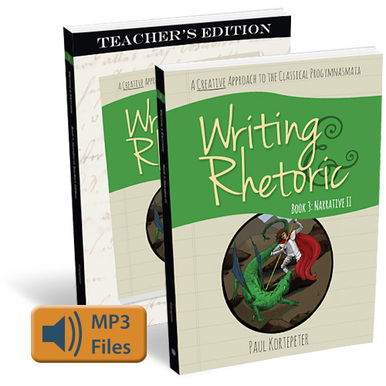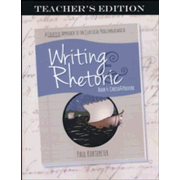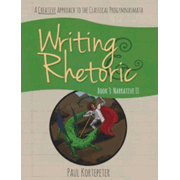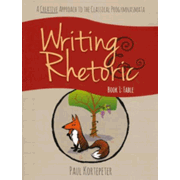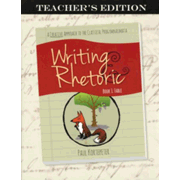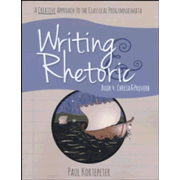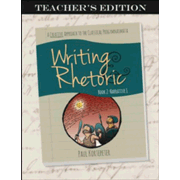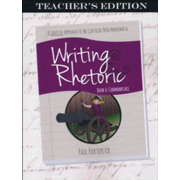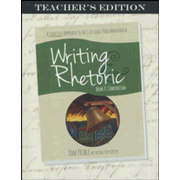The goal of the Writing & Rhetoric series is “to prepare students for rhetoric, which is the art of writing well and speaking persuasively” (Writing & Rhetoric: Fable, p. x). Many classical educators have begun to implement the progymnasmata, the ancient classical exercises for teaching writing and speaking skills. In the Writing & Rhetoric series, author Paul Kortepeter builds on the foundation of the progymnasmata and updates it with methods such as those recommended by Charlotte Mason.
The progymnasmata are based on the idea that children should learn how to write by working from exemplary models rather than by dreaming up their own ideas. So students work through models of various forms of writing, beginning with narratives and working up through expository, descriptive, and persuasive writing. Students simultaneously develop public speaking skills.
The series consists of twelve books, each of which should take one semester to complete. The twelfth book is still under development. Titles of all of the books, brief descriptions, and the publisher's suggested grade levels are as follows:
- Book 1: Fable - introduces narrative skills (grades 3-4)
- Book 2: Narrative I - narrations with descriptive elements (grades 3-4)
- Book 3: Narrative II - narrations with descriptive elements (grades 4-5)
- Book 4: Chreia & Proverb - expository essays with narrative, descriptive, and persuasive elements (grades 4-5)
- Book 5: Refutation & Confirmation - persuasive essays with narrative, descriptive, and persuasive elements (grades 5-6)
- Book 6: Commonplace - more-advanced persuasive essays with narrative, descriptive, and persuasive elements (grades 5-6)
- Book 7: Encomium & Vituperation - praise and criticism used within persuasive essays (grades 6-7)
- Book 8: Comparison - use of comparison within essays (grades 6-7)
- Book 9: Description & Impersonation - descriptive essays using characterizations of people and modeling writing (impersonation) after the styles of famous writers (grades 7-8)
- Book 10: Thesis Part 1 - persuasive essays developed to support a thesis (grades 7-8)
- Book 11: Thesis Part 2 - persuasive essays developed to support a thesis (grades 8-9)
- Book 12: Declamation: Attack and Defend a Law - persuasive essays or speeches bringing all of the elements of the progymnasmata to bear upon judicial matters(grades 8-9) (Not yet available)
Before beginning the first book, students need to be able to identify and write complete sentences. They need to be able to identify subjects and predicates, and they need to understand basic capitalization and punctuation. While the publisher's intent is that students begin this series in third or fourth grade, older students should also begin with the first book. Even though the books are suggested for students up through ninth grade, I see no reason why they shouldn't be used with students beyond ninth grade if the skills covered in Writing & Rhetoric have not yet been mastered. In fact, without the publisher's grade-level suggestions, I would have assumed that the last four books were all written for high school students.
The brief descriptions above do not convey the breadth of these books. Among the many skills developed as students work through the lessons are accurate copying, reading comprehension, creating and presenting oral and written narrations (retelling in the student's own words), public speaking, writing from dictation, expanding vocabulary, identifying points of view, outlining, writing dialogue, providing details to support an opinion, amplification (expanding upon a sentence, paragraph, or lengthier piece), summarizing, creating a story plot, developing characters in a story, and learning various ways to defend an argument.
As with most writing programs, the books cover a great deal of the language arts curriculum, but you still need to supplement with other resources that concentrate on grammar. The Writing & Rhetoric books each have from 10 to 14 lessons. If you complete two books per year, allotting one week per lesson, you will still have at least ten weeks to dedicate to grammar.
The models of writing used throughout this series are loosely connected to historical periods in a chronological fashion. Books 1 and 2 use fables and stories from ancient Greece and Rome. Book 3 draws from the period of the Roman Empire while Book 4 shifts into the Middle Ages. Books 5, 6, 7, and 8 cross the globe to the Americas, drawing upon U.S. history from the colonial period up through the Great Depression. It might be challenging to align Writing & Rhetoric books with history studies, but it certainly would be beneficial if you could tie them together for some years.
The teacher’s edition for each book has the complete student text with overprinted suggested answers, notes on the purpose of each lesson, dictation sentences (in Books 1 through 4), examples of responses for writing assignments, and occasional extra teaching notes. The lessons are very easy to follow. While parents should read through each week's lessons in advance so that they know the objectives and the assignments to come, the lesson preparation requires little time. These books are very user-friendly, even for inexperienced parents. With that said, the books aren't designed for independent study and the material does need to be presented by a parent or teacher.
Optional MP3 audio files feature the reading of the fables, narratives, legends, myths, and other excerpts presented in the books. While the audio files are optional, they are included with the purchase of the program (complete set) for each book. Using the audio files does not remove the need for a parent or teacher to lead discussions and interact with students in other ways.
These books build upon one another from Book 1 through Book 12 as students develop a foundation of skills by emulating and working from worthy models of writing. While the description of what is accomplished in this series might make it sound very difficult, the way the author presents bite-size pieces, coupled with suggestions for flexibility, should make it very manageable for most students.
While there are other publishers producing resources based on the progymnasmata, the Writing & Rhetoric series seems to me to have taken the best from the ancient models while also implementing some of the most effective techniques currently used. I expect that both students and parents will enjoy these books, and I think that the enjoyment can be shared even more effectively within a group class.
Following are specific details about the different books.
Books 1 through 4
Books 1 through 4 suggest dedicating three or four class sessions to each lesson. The lessons in each of these books generally follow a similar outline with an introduction, presentation of the story (or other writing model), and sections titled “Tell It Back—Narration,” “Talk About It,” “Go Deeper,” “Writing Time,” and “Speak It.” The activities within each section vary from lesson to lesson, and the variety keeps things interesting.
Lessons for the first day begin with the teacher reading the fable or narrative aloud with students following along. Students will then read the story aloud—to each other in pairs in a group class or to a parent when there's just one student. (While the lessons direct students to work with other students from time to time, those activities can usually be done either with a parent or independently.) In the “Tell It Back” section, students engage in narration, retelling the story in their own words. “Talk About It” presents a series of discussion questions. For example, after the fable “The Fox and the Grapes,” one question asks, “What is your definition of the idea of ‘sour grapes’? Use the expression ‘sour grapes’ in a complete sentence” (Book 1: Fable, p. 37). Some discussion questions relate to Scripture, current events, or other readings to help students learn to connect ideas.
In Books 1 though 3, students will also respond to the “Go Deeper” section which is a set of questions on vocabulary, grammar, main ideas, word usage, and character traits for students to answer in their textbook. Some questions require students to use a dictionary. In Book 4, the second day of the lesson should start with the “Go Deeper” exercises and then proceed to “Writing Time.”
In Books 1 through 3, on the second day of the lesson, students should reread the fable or narrative aloud to refresh their memories then proceed to the “Writing Time” exercises which generally begin with copywork and dictation. “Sentence Play” exercises within Writing Time have students work from partial or complete sentences to change them or expand upon them in some way. “Copiousness” exercises might have students first identify parts of speech, subjects, or predicates in the fable or narrative passage, then rewrite it by varying sentence elements. While students might write a summary of the passage, they might also be directed to “write an amplification with dialogue” or vary their rewrite of the passage in another way. Within Writing Time, students will complete other exercises, such as changing part of a passage or completely rewriting the story in a passage (e.g., from a different point of view).
Day three provides time for students to read aloud their revised or summarized stories. The “Speak It” exercises allow students to work on public speaking skills, discuss points raised for consideration in the instructions, or play games that relate to the use of language. The games usually work better in a group setting, but they can often be used with one student with only slight variations. A fourth lesson day will probably be required for a large group class to accomplish all of these activities, and it also provides flexibility regarding the pace and depth of study.
Books 5 through 10
The lessons in Books 5 through 10 continue to build upon the foundation laid in the previous books. The books become increasingly challenging and will take more time, so you need to plan either four or five days per lesson. Starting with Book 5, the books shift more toward expository writing in contrast to the stronger emphasis on narrative and descriptive writing found in the earlier books. In Book 5, students will begin learning how to revise their own written work.
Students continue with some of the same types of activities as in earlier books—narration, recitation, writing, vocabulary study, and public speaking. Starting in Book 6, students also engage in a new exercise entitled “Memoria,” in which they memorize a quotation related to a lesson theme. The beginning literary analysis skills introduced to students in earlier books are further developed as well. Logic and critical thinking come into play as students learn to evaluate and present their own arguments. The following summary of Lesson 2 in Book 7 should give you an idea of the shift that takes place from the lower-level books.
The lesson, "Biography versus Autobiography" begins with an explanation of those two literary forms. Following this are two stories about different periods in the life of William "Buffalo Bill" Cody—one a biography and the other an autobiography. In the "Tell It Back" assignments, students will explain the nature of biographies and autobiographies. They will then narrate one of the stories either orally or in writing.
Next, students mark up the text of the stories, identifying the main ideas and important points. They will write comments in the margins, put question marks next to things they don't understand, and circle proper nouns. They will also circle and look up the meanings of unfamiliar words.
In the "Talk About It" section, they'll discuss the advantages of autobiography over biography as well as the concept of ethos in regard to both forms of writing. (As is explained in the textbook, ethos refers to a rhetorical appeal to the trustworthiness of a source.)
The "Memoria" section begins with a quote about hate from Dr. Martin Luther King, Jr. Students will read the quote, learn the meanings of unfamiliar words, and discuss how it relates to the readings about Buffalo Bill. They will then memorize the quotation for recitation during the next class session. They will also write the quote in their notebook, adding any thoughts they might have about it.
"Go Deeper," the final section of Lesson 2 in Book 7, presents four writing assignments. (Teachers are told that they might assign the first two for oral presentations or discussion if that seems better.) The first assignment asks students to identify differences between the two Buffalo Bill narratives. The second has them write a paragraph in praise of character qualities of either Buffalo Bill or his parents (an encomium). The third assignment presents an autobiographical excerpt for students to turn into a biography, and the fourth presents a biographical excerpt for them to transform into an autobiography.
In Book 7, students will begin to use MLA guidelines as they create note cards, in-text citations, and a works-cited page. In this book, even when they are asked to write lengthy papers, students are given assistance in the form of outlines. They will not need to create their own outlines from scratch until a later book in this series. Until then, they practice outlining by working from the literary excerpts provided for them. This method of working from other literary works to develop skills continues to make skill development much easier than if students were required to come up with their own original compositions from scratch.
Book 8 continues to work on outlines, structure, quotations, and other concepts that were previously introduced. In addition, students learn to write comparison essays, comparing two subjects, an exercise that builds on the skills students have been developing since writing their first six-paragraph essays in Book 6. Book 9 shifts to descriptive essays in which the writer appeals to the five senses.
Book 10 introduces the thesis essay. Using skills they have learned previously in narrative, descriptive, expository, and comparative writing, students write an essay that will persuade the reader to accept their thesis statement. Students learn how to come up with a thesis statement that grabs their audience's attention, and they write an essay that supports that thesis.
Book 11 continues students’ study of the thesis, which will aid them in examining and sustaining ideas. Nearly every lesson is organized around foundational principles and inspiring selections from great writing. Narration, questions for discussion, and exercises in speech writing all emerge within the context of these principles and reading selections.




